Mazda CX-5 Owners Manual: How the SRS Air Bags Work
Your Mazda is equipped with the following types of SRS air bags. SRS air bags are designed to work together with the seat belts to help to reduce injuries during an accident.
The SRS air bags are designed to provide further protection for passengers in addition to the seat belt functions. Be sure to wear seat belts properly.
Front Seat Belt Pretensioners
The front seat belt pretensioners are designed to deploy in moderate or severe frontal, near frontal collisions. In addition, during a side collision, the pretensioner operates on the side in which the collision occurs.
(With Driver and Front Passenger Occupant Classification System)
The front seat belt pretensioners are also designed to deploy in a roll-over accident.
Driver Air Bag
The driver's air bag is mounted in the steering wheel.
When air bag crash sensors detect a frontal impact of greater than moderate force, the driver's air bag inflates quickly helping to reduce injury mainly to the driver's head or chest caused by directly hitting the steering wheel.
For more details about air bag deployment, refer to “SRS Air Bag Deployment Criteria” .
(With Driver and Front Passenger Occupant Classification System)
The driver's dual-stage air bag controls air bag inflation in two energy stages. During an impact of moderate severity the driver's air bag deploys with lesser energy, whereas during more severe impacts, it deploys with more energy.
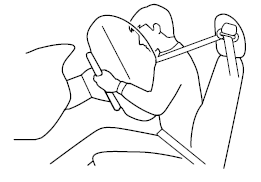
Front Passenger Air Bag
The front passenger air bag is mounted in the front passenger dashboard.
The inflation mechanism for the front passenger air bag is the same as the driver's air bag, as mentioned above.
For more details about air bag deployment, refer to “SRS Air Bag Deployment Criteria” .
(With Driver and Front Passenger Occupant Classification System)
In addition, the front passenger air bag is designed to only deploy in accordance with the total seated weight on the front passenger seat. For details, refer to the driver and front passenger occupant classification system .
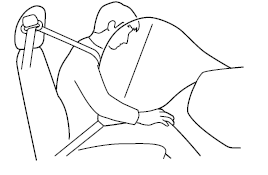
Side Air Bags
The side air bags are mounted in the outboard sides of the front seatbacks.
When the air bag crash sensors detect a side impact of greater than moderate force, the system inflates the side air bag only on the side in which the vehicle was hit. The side air bag inflates quickly to reduce injury to the driver or front passenger's chest caused by directly hitting interior parts such as a door or window.
For more details about air bag deployment, refer to “SRS Air Bag Deployment Criteria” .
(With Driver and Front Passenger Occupant Classification System)
In addition, the front passenger side air bag is designed to only deploy in accordance with the total seated weight on the front passenger seat. For details, refer to the driver and front passenger occupant classification system .
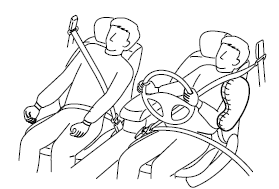
Curtain Air Bags
The curtain air bags are mounted in the front and rear window pillars, and the roof edge along both sides.
When the air bag crash sensors detect a side impact of greater than moderate force, the curtain air bag inflates quickly and helps to reduce injury mainly to the rear outboard passenger's head caused by directly hitting interior parts such as a door or window.
For more details about air bag deployment, refer to “SRS Air Bag Deployment Criteria” .
In a side impact:
Greater than moderate impact to one side of the vehicle will cause the curtain air bag on that side only to inflate.
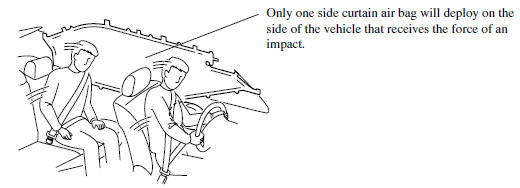
(With Driver and Front Passenger Occupant Classification System)
In a roll-over:
In response to a vehicle roll-over, both curtain air bags inflate.
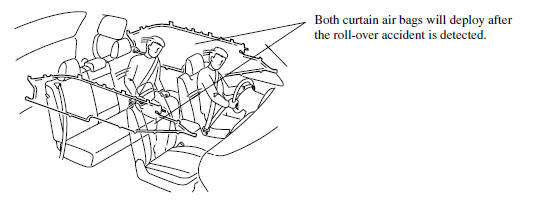
(With Driver and Front Passenger Occupant Classification System) In an angled collision:
During a collision, driver/front passenger air bag and the curtain air bag will deploy.
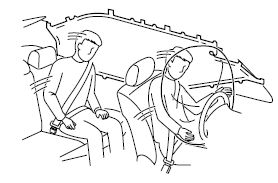
Warning Light/Beep
A system malfunction or operation conditions are indicated by a warning.
Refer to Warning/Indicator Lights 5.
Refer to Air Bag/Front Seat Belt Pretensioner System Warning Beep 2.
 Supplemental Restraint System Components
Supplemental Restraint System Components
1 Driver/Front passenger inflators and air bags
2 Roll-over sensorí, crash sensors, and diagnostic module (SAS unit)
3 Front seat belt pretensioners
4 Front air bag sensors
5 Side crash ...
 SRS Air Bag Deployment Criteria
SRS Air Bag Deployment Criteria
This chart indicates the applicable SRS equipment that will deploy depending
on the type of collision.
(The illustrations are the representative cases of collisions.)
X: The SRS air bag equipmen ...
Other materials:
Starter Removal/Installation [Skyactiv G 2.0]
WARNING:
Remove and install all parts when the engine is cold, otherwise they can
cause severe burns or serious injury.
When the battery cables are connected, touching the vehicle body with starter
terminal B will generate sparks. This can cause personal injury, fire, and d ...
Spare Tire and Tool Storage
Spare tire and tools are stored in the locations illustrated in the diagram.
Except Mexico
Mexico
Jack
To remove the jack
1. Open the trunk board.
2. Secure the trunk board by attaching the hook to the head restraint.
Without luggage compartment cover
With luggage compartment cover
...
Power Supply Switching
Outline
By pressing the push button start, switching of the power supply is performed.
Function
The start stop unit switches the power supply according to the vehicle conditions
such as the selector lever (ATX)/shift lever (MTX) position and the pedal depression/release
whe ...
